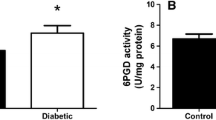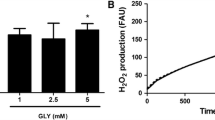Abstract
Considerable evidence suggests that oxidative stress plays an important role in tissue damage associated with hypoglycemia and other metabolic disorders. The altered brain neurotransmitters metabolism, cerebral electrolyte contents, and impaired blood-brain barrier function may contribute to CNS dysfunction in hypoglycemia. The present study elucidates the effect of starvation and insulin-induced hypoglycemia on the free radical scavanger system—reduced glutathione (GSH) content, glutathioneS-transferase (GST), glutathione peroxidase (GPx), glutathione reductase (GR), γ-glutamyl transpeptidase (γ-GTP), γ-glutamyl cystein synthetase (γ-GCS), catalase and superoxide dismutase (SOD), and mitochondrial electron transport chain (ETC) complexes I–IV from three different regions of rat brain, namely cerebral hemispheres (CH), cerebellum (CB), and brainstem (BS). Peripheral organs, such as liver and kidney, were also studied. Significant changes in these enzymic activities were observed. The analysis of such alterations is important in ultimately determining the basis of neuronal dysfunction during metabolic stress conditions, such as hypoglycemia, and also defining the nature of these changes may help to develop therapeutic means to cure metabolically stressed tissues.
Similar content being viewed by others
References
Aebi H. (1984) Catalase in vitro.Methods Enzymol. 103, 121–126.
Agardh C. D., Kalimo H., Olesson Y., and Siesjö B. K. (1981) Hypoglycemic brain injury, metabolic and structural findings in rat cerebellar cortex during profound insulin induced hypoglycemia and the recovery period following glucose administration.J. Cereb. Blood Flow. Metab. 1, 71–84.
Almeida A., Brooks K. J., Sammut I., Keelan J., Davey G. P., Clark J. B., et al. (1995) Postnatal development of complexes of the electron transport chain in synaptic mitochondria from rat brain.Dev. Neurosci. 17, 212–218.
Auer R. N. and Siesjö B. K. (1988) Biological differences between ischemia, hypoglycemia and epilepsy.Ann. Neurol. 24, 699–707.
Beal M. F. (1992) Does impairment of energy metabolism result in excitotoxic neuronal death in neurodegenerative illnesses?.Ann. Neurol. 31, 119–130.
Beal M. F., Hyman B. T., and Koroshetz W. (1993) Do defects in mitochondrial energy metabolism underlie the pathology of neurodegenerative diseases?.Trends Neurosci. 16, 125–131.
Carlberg I. and Mannervik A. (1975) Purification and characterization of flavoenzyme glutathione reductase from rat liver.J. Biol. Chem. 250, 5475–5480.
Chapman A. G., Westerberg E., and Siesjö B. K. (1981) The metabolism of purine and pyrimidine nucleotides in rat cortex during insulin induced hypoglycemia and recovery.J. Neurochem. 36, 179–186.
Coyle J. T. and Puttfarcken P. (1993) Oxidative stress, glutamate and neurodegenerative disorders.Science 262, 689–695.
Flohe I. and Gunzler W. A. (1984) Assay of glutathione peroxidase.Methods Enzymol. 105, 114–121.
Ghajar J. B. G., Plum F., and Duffy T. E. (1982) Cerebral oxidative metabolism and blood flow during acute hypoglycemia and recovery in unanesthetised rat.J. Neurochem. 38, 397–409.
Goto Y., Nomaka I., and Horai S. (1990) A mutation in tRNA (Leu)(UVR) gene associated with the MELAS subgroup of mitochondrial encephalopathies.Nature 348, 651–653.
Griffith O. W. and Meister A. (1985) Origin and turnover of mitochondrial glutathione.Proc. Natl. Acad. Sci. USA 82, 4666–4672.
Habig W. H., Pabst M. J., and Jakoby W. B. (1974) Glutathione S Transferase: The first enzymatic step in mercapturic acid formation.J. Biol. Chem. 249, 7130–7139.
Hatefi Y. and Rieske J. S. (1967) Preparation and properties of DPNH Coenzyme Q Reductase (complex-I of the respiratory chain).Methods Enzymol. 10, 235–239.
Hourani H., Lacy B., Eltayeb K., and Abumrad N. N. (1992) The role of the central nervous system in modulating glucose and protein metabolism during insulin induced hypoglycemia.Brain Res. 587, 276–284.
Jain A., Martensson J., Stole E., Auld P. A. M., and Meister A. (1991) Glutathione deficiency leads to mitochondrial damage in brain.Proc. Natl. Acad. Sci. USA 88, 1913–1917.
Kalimo H., Auer R. N., and Siesjö B. K. (1985) The temporal evolution of hypoglycemic brain damage III. Light and electron microscopic findings in the rat caudoputamen.Acta Neuropathol. 67, 37–50.
Kono Y. (1978) Generation of superoxide radical during autoxidation of hydroxylamine and an assay of superoxide dismutase.Arch. Biochem. Biophy.,186, 189–195.
Krishnamoorthy G. and Hinkle P. C. (1988) Studies on the electron transfer pathway, topography of iron-sulfur centers and site of coupling in NADH-Q oxidoreductase.J. Biol. Chem. 263, 17,566–17,575.
Kumar J. S. S. and Menon V. P. (1993) Effect of diabetes on levels of lipid peroxides and glycolipids in rat brain.Metabolism 42, 1435–1439.
Lowry O. H., Rosebrough N. J., Farr A. L., and Randall R. J. (1951) Protein measurement with the Folin phenol reagent.J. Biol. Chem. 193, 265–275.
Makar T. K., Nedergaard M., Preuss A., Gelbard A. S., Perumal A. S., and Cooper A. J. L. (1994) Vitamin E, ascorbate, glutathione, glutathione disulfide and enzymes of glutathione metabolism in cultures of chick estrocytes and neurons: Evidence that astrocytes play an important role in antioxidant processes in brain.J. Neurochem. 62, 45–53.
Meister A. (1983) Selective modification of glutathione metabolism.Science 220, 472–477.
Naftalin L., Sexton M., Whitaker J. F., and Tracey D. (1969) A routine procedure for estimating serum γ-glutamyl transpeptidase activity.Clin. Chim. Acta 26, 293–296.
Parker W. D., Jr., Boyson S. J., and Parks J. K. (1989) Abnormalities of the electron transport chain in idiopathic Parkinson’s disease.Ann. Neurol. 26, 719–723.
Parker W. D. Jr. and Parks J. K. (1995) Cytochrome C oxidase in Alzheimer’s disease brain: purification and characterization.Neurology 45, 482–486.
Partridge R. S., Monroe S. M., Parks J. K., Johnson K., Parker W. D. Jr. Eaton G. R., et al. (1994) Spin trapping of azidyl and hydroxyl radicals in azide-inhibited rat brain submitochondrial particles.Arch. Biochem. Biophys. 310, 210–217.
Rieske J. S. (1967) Preparation and properties of reduced Coenzyme Q Cytochrome C Reductase (complex-III of respiratory chain).Methods Enzymol. 10, 239–245.
Sedlak J. and Lindsay R. H. (1968) Estimation of total, protein bound and nonprotein sulfhydryl groups in tissues with Ellman’s reagent.Anal. Biochem. 25, 192–205.
Salo D. C., Pacifici R. E., Lin S. W., Giulivi C., and Davies K. J. (1990) Superoxide dismutase undergoes proteolysis and fragmentation following oxidative modification and inactivation.J. Biol. Chem. 265, 11,919–11,927.
Santos M. S., Moreno A. J., and Carvalho A. P. (1996) Relationships between ATP depletion, membrane potential and the release of neurotransmitters in rat nerve terminals. An in vitro study under condition that mimic anoxia, hypoglycemia, and ischemia.Stroke 27, 941–950.
Seelig G. F. and Meister A. (1985) Glutathione biosynthesis: γ-glutamyl cysteine synthetase from rat kidney.Methods Enzymol. 113, 379–390.
Siesjö B. K. (1981) Cell damage in the brain: a speculative synthesis.J. Cereb. Blood Flow. Metab. 1, 155–185.
Siesjö B. K. (1988) Mechanisms of ischemic brain damage.Crit. Care Med. 16, 954–963.
Siesjö B. K. and Bengtsson F. (1989) Calcium fluxes, calcium, antagonists, and calcium-related pathology in brain ischemia, hypoglycemia and spreading depression: a unifying hypothesis.J. Cereb. Blood Flow. Metab. 9, 127–140.
Smith M. L., Von Hanwehr R., and Siesjö B. K. (1986) Changes in extra- and intracellular pH in the brain during and following ischemia in hyperglycemic and in hypoglycemic rats.J. Cereb. Blood Flow Metab. 6, 574–583.
Swerdlow R., Marcus D. L., Landman J, Kooby D, Frey W. 2nd, and Freedman M. L. (1994) Brain glucose metabolism in Alzheimer’s disease.Am. J. Med. Sci. 308, 141–144.
Turski L. and Turski W. A. (1993) Towards an understanding of the role of glutamate in neurodegenerative disorders: energy metabolism and neuropathology.Experentia 49, 1064–1072.
Wallace D. C., Zheng X. X., Lott M. T., Shoffner J. M., Hodge J. A., Kelley R. I., et al. (1988) Familial mitochondrial encephalomyopathy (MERRF) genetic, pathophysiological, and biochemical characterization of a mitochondrial DNA disease.Cell 55, 601–610.
Wieloch T., Harris R. J., Syman L., and Siesjö, B. K. (1984) Influence of severe hypoglycemia on brain extracellular calcium and potassium activities, energy and phospholipid metabolism.J. Neurochem. 43, 160–168.
Yonetani T. (1967) Cytochrome oxidase.Methods Enzymol. 10, 332–335.
Ziegler D. and Rieske J. S. (1967) Preparation and properties of succinate dehydrogenase coenzyme Q reductase (complex-II).Methods Enzymol. 10, 231–235.
Author information
Authors and Affiliations
Corresponding author
Rights and permissions
About this article
Cite this article
Bhardwaj, S.K., Sharma, M.L., Gulati, G. et al. Effect of starvation and insulin-induced hypoglycemia on oxidative stress scavenger system and electron transport chain complexes from rat brain, liver, and kidney. Molecular and Chemical Neuropathology 34, 157–168 (1998). https://doi.org/10.1007/BF02815077
Received:
Accepted:
Issue Date:
DOI: https://doi.org/10.1007/BF02815077




